
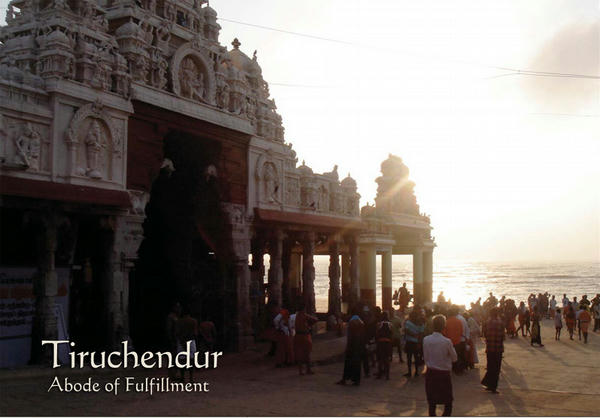
HINDUISM TODAY§
Rising high: Sunrise at the Shanmuga Vilasam
• • • • • • • • • • •§
 EEP IN THE SOUTH OF TAMIL NADU LIES THE FAMED SPIRITUAL center called Tiruchendur. Trains and buses ply their way incessantly from Madurai. We take the early morning train to Tirunelveli, and then a 41-km taxi ride to Tiruchendur, winding through the traditional rural landscape, unchanged for centuries. Driving by rice paddies and groves of palmyra and banana, we feel we are journeying back in time.§
EEP IN THE SOUTH OF TAMIL NADU LIES THE FAMED SPIRITUAL center called Tiruchendur. Trains and buses ply their way incessantly from Madurai. We take the early morning train to Tirunelveli, and then a 41-km taxi ride to Tiruchendur, winding through the traditional rural landscape, unchanged for centuries. Driving by rice paddies and groves of palmyra and banana, we feel we are journeying back in time.§
Pilgrims approach the Arulmigu Sri Subrahmanya Swami Tirukkoyil via a magnificent, covered, open-air walkway that extends 750 meters from the town’s center. It is flanked by an overwhelming menagerie of stalls selling garlands, fruits and other offerings, religious music, colorful cloth and objects for the home shrine. Approaching slowly, we soon spot the temple’s grand, nine-tiered mela gopuram. This white stone tower displaying an enormous blue vel is a striking landmark, visible to sailors from miles away at sea and beckoning devotees from all around. This west entrance, we are told, is only opened during the temple’s annual festival.§
Catching the smell of sea air, we know we are near. Exiting the corridor, we take in the full view of the seashore, the temple perched on a gentle slope only a few meters to the left. Here the salty waters of the Gulf of Mannar lap against a broad, sandy beach where pilgrims bathe in the sea before entering the temple. The primary entrance to the temple is here, facing south. Called the Shanmuga Vilasa mandapam, it is an ornately carved, 124-pillar hall standing as a testament to the craftsmanship that prevailed in the era when this temple was built. We are told the temple was originally built of sandstone, thus the name Tiruchendur, “Holy Red City.” When that eroded away, it was rebuilt in granite. Priests are everywhere. We speak with a few in hopes of making arrangements to have darshan of Murugan at tomorrow’s early morning abhishekam.§
In the month of Markali, worship begins at Tiruchendur at 3 am. We arise before dawn and take the short walk to the temple. The dimly lit sanctuary is already crowded with devotees. At 5:30 we are ushered to the ocean-facing main shrine. We are three of fifteen people paying Rs 200 (us$5) for tickets allowing us to sit right before the sanctum.§

HINDUISM TODAY§
Tiruchendur’s 140-foot-tall gopuram
• • • • • • • • • • •§
The granite statue is Balasubrahmanyaswami, the pious young ascetic. Several paintings in the temple describe the legend: Murugan encamped at Tiruchendur before and after defeating the demon Surapadman and his malevolent band. Kneeling by a small Lingam, He worshiped His Father, Siva, seeking forgiveness for his necessary but regrettable act of killing. Devas arrived in multitudes to thank Murugan for saving them from the demons’ wrath, and He quickly stood up to bless them. It is this position in which the murti was created, holding flowers in one hand and a mala of rudraksha beads in the other, utterly absorbed in adoration of God Siva.§
That those who seek His love be blessed with boons, one face responds in melting love to their behest. That no ills befall the devout who offer oblation ordained in the sacred Vedas, one face benign takes care. That the seers be enlightened on the many hidden truths, one face resplendent illumines every quarter like the moon.§
TIRUMURUGARRUPADAI, LINES 93-98§
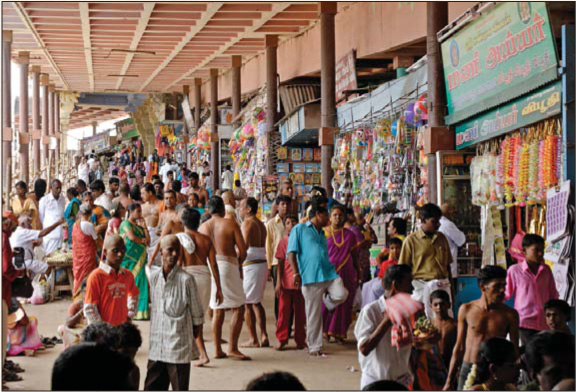
Ubiquitous devotion: Stalls selling religious items clutter the covered walkway leading to the temple§

M. AMIRTHAM/DINODIA§
Inside the Shanmuga Vilasa mandapam§
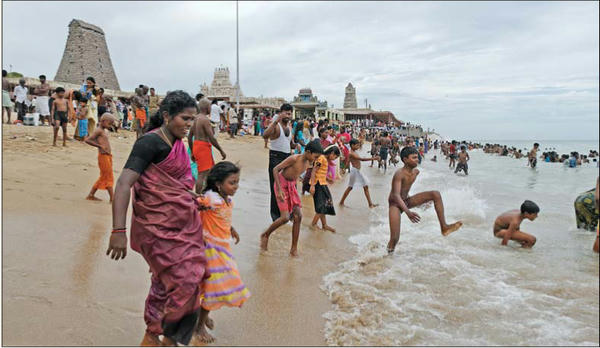
M. AMIRTHAM/DINODIA§
Families joyously bathe in the ocean prior to entering the temple§
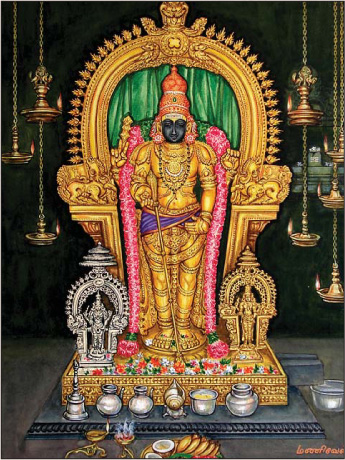
A. MANIVEL§
A painting of the main murti
• • • • • • • • • • •§
We sit humbly before the Deity, a striking image coated from head to toe with sandalwood paste. The priest deftly removes the fragrant covering and proceeds to pour oil, panchamritam and liter after liter of milk—so much milk, the ablution seems to last an eternity. When milk is poured, this glorious murti turns evenly white all over, revealing details in the dark stone and evoking intense devotion among the priests and devotees. The final ablution is with vibhuti, holy ash. The priest carves out a beaming smile for Murugan in the white coating. This evokes a spectrum of emotions among the devotees—from energetic bhakti to delicate smiles and quiet laughter. We find that this deeply devotional rite has connected us to Murugan in a new way. A half-hour after the puja began, it is complete, and we are quickly ejected back out into the crush of devotees streaming by the shrine for a glimpse of Murugan in the day’s regal attire.§
Not far from the main sanctum, we come upon the south-facing shrine of the utsava murti. This bronze image, which is paraded around the temple during festivals, is so bright it looks as if its composition could be mostly gold. We learn from a fascinating collection of paintings displayed in the third prakaram that Dutch invaders arrived in the 17th century and stole the precious murti. Encountering a massive thunderstorm at sea, the plunderers grew fearful, believing their crime had cursed them, and heaved the booty overboard. The Nayak king who patronized the temple at the time instructed his local representative, Vadamalaiappa Pillai, to have a new murti made. In the meantime, Lord Subrahmanyam appeared to Vadamalaiappa in a dream, indicating the exact spot where the murti lay. Men were sent out in ships to recover it. As foretold in the dream, a lime floating in the water and a kite bird flying directly above marked the Deity’s location on the sea floor. Retrieving the murti, they returned it to the temple. But the temple’s hereditary priesthood refused the king’s order to welcome the desecrated image. The king, adamant that the Deity be restored to its respected position, commissioned a separate family of Adisaiva priests to reinstall it and conduct the daily rites. To this day, that same clan of Adisaivas operates the shrine, completely independent of the other shrines and activities at the temple.§
One afternoon we visit Nalikkinaru, the fresh-water well only meters from the shore, where Murugan is said to have cleaned His vel. Fed by an underground spring, it never dries up, even in severe drought. The water is believed to heal ailments of all kinds.§
On our third day, we rise just before the Sun. Making our way to the temple, we enjoy the morning fragrances as the town awakes and prepares for its day: fresh dosai, hot sambar, sweet rose milk. The bliss permeating this town is amazing. Every time we stop and stand quietly, all we can feel is this sublimity. All here rings with a happy contentedness, a feeling that everything is all right, right now. Perhaps it’s the location at the seaside, the clean air or the presence of the playful child Murugan that lends a sweetness and mellowness to everyone and everything at Tiruchendur.§
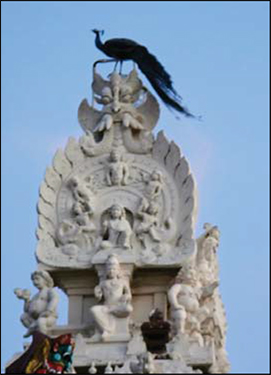
HINDUISM TODAY§
Holy precincts: A peacock settles in for the night atop the south gopuram§
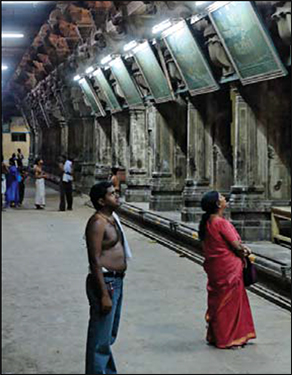
M. AMIRTHAM/DINODIA§
Devotees enjoy art which tells the story of 17th-century Dutch thieves§
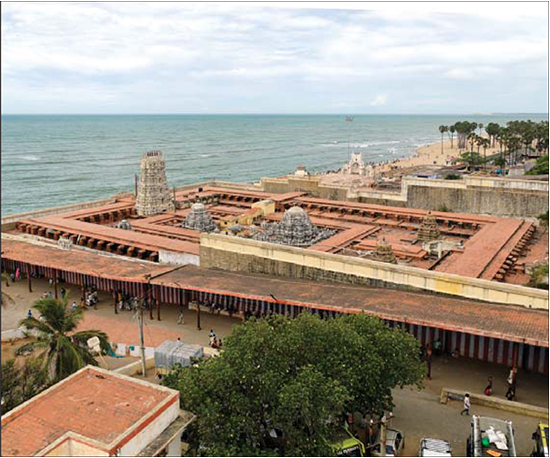
M. AMIRTHAM/DINODIA§
This temple, right on the sea, was miraculously spared when the 2004 Asian Tsunami devastated neighboring towns
• • • • • • • • • • •§
Hundreds of Ayyappaswami’s pilgrims on their way to Kerala are bathing in the ocean in anticipation of the sun’s imminent rising. A peacock, perched royally atop the gopuram of the Shanmuga Vilasam, calls out. Is he the same one we saw there at dusk last night? Kites circle overhead just offshore, bringing to mind the story of the Dutch and the utsava murti. Devotees are gathered out on the rocks, others on the beach, still others in an open-air mandapam abutting the temple. Cows saunter through the dispersed crowd; pilgrims like us touch them for blessings. Goats and dogs, young and old, and one cat, meander among pilgrims as the rising Sun marks the new day’s beginning.§
After darshan of Lord Murugan in the sanctum, we continue our exploration of this cavernous edifice. Vast halls and corridors have been added over centuries. One of the delights is to roam these passageways as the sea breeze blows through. This is a grand temple, a true work of art and devotion in granite. It gets quieter and quieter as ones goes ‘round the second prakaram and further out into the third. There are solitary hideaways for private meditation. On the north side of the third prakaram we encounter a shrine for Vishnu carved out of the rock itself, with a monolithic, larger-than-life, reclining murti.§
Continuing our pradakshina, we notice two men working quietly inside a small, granite-walled chamber. They are laboriously grinding sandalwood on a big, wet, granite slab, slightly funnel-shaped toward one end to collect the paste.§
The use of sandalwood is famous here at Tiruchendur. According to Sivakamasundari Shanmugasundaram, reporting for HINDUISM TODAY in 2002, the temple spends about $150,000 per year for this aromatic, yellowish heartwood. While sandalwood is a primary sacrament used abundantly in Hindu worship, doubtless no other temple in India buys as much of it. Huge amounts are ground fresh daily right here as has been done for millennia. Applied to the Deity during puja, the cooling, fragrant paste is then given as prasadam to devotees who lavishly smear it on their face, arms and body, to soothe, to bless, to heal.§
For the 30,000 devotees who visit every day, this ocean-side temple of magic radiates the peace that remains after all desires have been fulfilled. The serenity makes an durable mark in the mind, concealing any hint of the intensity that awaits us at Murugan’s next encampment.§
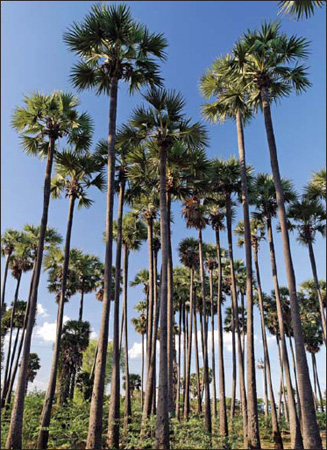
M. AMIRTHAM/DINODIA§
Traditional resource: Ever-useful palmyra trees dominate the seaside landscape around Tiruchendur§